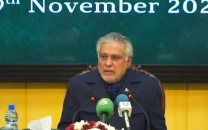US drone strike kills 6
US drones fires four missiles into a vehicle in the town of Angoor Adda in South Waziristan.

US drone strike kills 6
Unmanned aircraft fired four missiles into a vehicle travelling through the South Waziristan district, targeting a common root for Taliban and Al-Qaeda-linked militants who infiltrate Afghanistan to attack US troops.
"It was a US drone attack. Four missiles were fired. The target was a vehicle. Several militants were killed. The death toll is six," a Pakistani military official told AFP on condition of anonymity.
Another Pakistani security official confirmed the same details of the attack near the small town of Angoor Adda in South Waziristan, around six kilometres (four miles) from the border with Afghanistan.
Pakistani intelligence officials said the dead belonged to the Haqqani group, an Al-Qaeda-allied outfit run by Afghan warlord Sirajuddin Haqqani and based in the neighbouring North Waziristan tribal district.
An administration official in South Waziristan said those who died were "all Afghans. They were in pick up which came under attack."
The Haqqani group is loyal to the Taliban and has been blamed for some of the deadliest anti-US attacks in Afghanistan, including a suicide attack at a US base in Khost in 2009 that killed seven CIA operatives.
The attack came just one day after a Washington meeting between Lieutenant General Ahmad Shuja Pasha, the chief of Pakistan's Inter-Services Intelligence agency, and Leon Panetta, director of the CIA, which runs the drone war.
George Little, a CIA spokesman, told AFP the talks were productive and that relations between the agency and the ISI remained on a "solid footing."
It was the first missile strike since March 17, when Pakistan's civilian and military leaders strongly protested over a US drone attack that killed 39 people, including civilians and police, in North Waziristan.
Analysts said any expectations that the CIA would abandon the drone campaign despite a series of diplomatic rows with Pakistan were misplaced, even if Pakistani leaders, for domestic political purposes, criticised the strikes.
"My assumption is there would be some kind of understanding for limited drone strikes," said political and security analyst Hasan Askari.
"Drone strikes also serve Pakistan's interest. These strikes take place in the areas that are not firmly under Pakistan's control. Therefore, they weaken militant elements".
This week, the New York Times reported that Pakistan told the United States to rein in drone strikes and slash the number of CIA agents and special forces operating in the conservative, nuclear-armed Muslim country.
The paper said the order highlighted the near collapse of US-Pakistani cooperation since a CIA contractor shot and killed two men who allegedly tried to rob him in broad daylight on the streets of Lahore in January.
The article quoted a Pakistani official saying that Pakistan's military "would like the drones stopped," after complaining that the Obama administration's expanded drone attacks had run out of control.
If they cannot be stopped, Pakistan's army chief of staff Ashfaq Kayani demanded, then the drone campaign should return to its original more limited scope and target areas within North Waziristan, the paper said.
The drone strikes inflame anti-US feeling, which is running high after the row over the CIA contractor and recent White House criticism of Pakistan's efforts to defeat the Taliban in the tribal belt on the Afghan border.
Missile attacks doubled in the area last year, with more than 100 drone strikes killing over 670 people in 2010 compared with 45 strikes that killed 420 in 2009, according to an AFP tally.
Most have been concentrated in North Waziristan, the most notorious Afghan Taliban and Al-Qaeda bastion in Pakistan, where the United States wants the Pakistan military to launch a ground offensive as soon as possible.
Pakistan says its troops are too overstretched to launch such an assault.
The United States does not confirm drone attacks, but its military and the CIA operating in Afghanistan are the only forces that deploy them in the region.













COMMENTS
Comments are moderated and generally will be posted if they are on-topic and not abusive.
For more information, please see our Comments FAQ